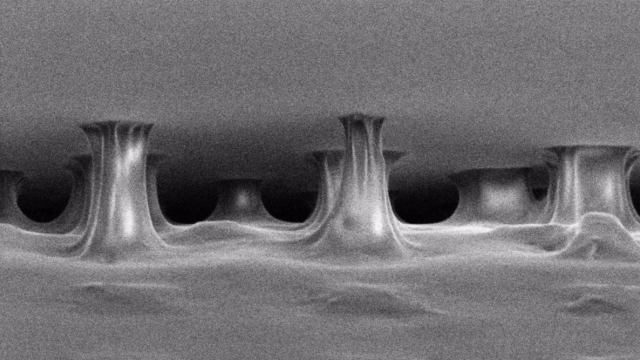There’s a certain patience required for studying sticky tape. Sure, sometimes experiments require peeling, but other times, researchers must simply sit around and wait for the adhesive to fail. These experiments are bringing scientists closer to something that doesn’t yet exist: a unified theory of tape.
Tape isn’t just for attaching posters to walls—it finds use throughout industry, from surgeries to iPhones to cars. But on the smallest scales, it’s not entirely clear how it works, and finding the right adhesive for a job can be a matter of maddening trial-and-error. A theoretical understanding of how and why tapes peel could help companies develop new stronger, adhesives.
“If you understand how this works, then you understand how more complicated things work,” Helen Minsky, postdoctoral researcher at ESPCI Paris, explained to Gizmodo.
But first: What is tape? “Tape is a soft material used to hold things together,” Minsky said. On the microscopic scale, two harder surfaces that come into contact don’t meet at many places. But tape’s extreme softness allows it to fill in those spaces. Molecules can interact with one another through various short-range inter-atomic forces. Tape maximizes the number of places where these surfaces come into contact, leading to higher amounts of these inter-atomic forces and thus to its sticky nature.
Additionally, it’s dissipative, meaning that it loses the energy you used to stick it to the surface. The tape’s shape conforms to the solid. But removing the tape takes a lot more energy, thanks to the tape’s internal properties. Tapes are complex, and are often specialised to adhere to certain surfaces, from rocket parts to skin.
Of more concern than how tape sticks is how tape unsticks. Sure, it might not be a big deal if the tape unsticks in your iPhone, but if automotive builders have opted to use tape instead of welding parts together, they better understand what forces will cause the tape to fail.
Scientists are mainly concerned with three different ways tape can unstick: It can peel, when the adhesive is attached to a flexible film and removed; it can shear, which is like peeling but parallel to the surface; or it can tack, when you press something directly down into exposed adhesive and then pull back up.
Today, scientific theory fails to fully unite shear, peel, and tack, according to ESPCI scientist Matteo Ciccotti, and tape has “defied many modelling attempts over the past 70 years,” he and his team write in one paper.
The difficulty is due to the complexities of the unsticking process. Tape first develops cavities between the adhesive and the surface to which it’s stuck. These cavities grow, and eventually the adhesive stretches into long fibres 10 times the tape’s initial thickness before they snap. It can take a hundred to a thousand times more energy to stretch and break the fibres than it would take to simply break the individual bonds between the tape’s atoms and the atoms of the surface, said Ciccotti.
Energy is lost both to stretching the fibres out, the viscous flow of the material, and to their actual breaking. Theories that explain soft polymers that deform or flow under pressure then regain their shape don’t describe the extreme strain the tape fibres can withstand. Theories explaining thick fluids wouldn’t explain the way that fibres cleanly detach after stretching. Theories that explain fracturing material don’t correctly predict the large energies required for unsticking the tape. They also give seemingly unrelated results for peel, shear, and tack.
But industrial applications require knowing a particular tape’s limits under different kinds of strain, so it’s a problem that existing theories don’t link them. Today, knowing that a tape performs well under a tack test doesn’t confirm that it will perform well under a shear test, as the fibres behave differently under these different conditions.
That’s why Ciccotti, as well as Costantino Creton and Etienne Barthel at ESPCI Paris, are attempting to unify all of these pieces into a single theory. In their experiments, they remove tapes from surfaces at different speeds and angles, measuring the forces and imaging the results with high-powered microscopes. “We’d like to devise one approach to predict the performance of tape under these different kinds of tests,” Ciccotti said. More recently, they’ve even introduced molecules that light up under stress or when they break, which could help them get close to a universal model of sticky tape.
These are gruelling experiments, Minsky explained. “A lot of my day involves waiting for the tapes to fail.”
The team has already made several important theoretical advances in the understanding of tape, most notably in how it behaves when it shears, or slides along the surface. With further validation, their work will help other scientists anticipate how and when tape will start to fail, Carlos Barrios, researcher at 3M, told Gizmodo. “The appropriate theoretical models that help to understand the location, magnitude, and direction of the stresses that materials will experience when being part of an adhesive bond, may validate why some of our solutions work so well,” he said, “and provide an extra design tool for developers to use when creating new adhesives solutions.”
Ultimately, this kind of research is valuable both to help engineers spend less time guessing and more time producing optimal tapes, and to fundamental science. Indeed, the science behind tape is an excitingly complex mystery to unravel.
“There are lots of things that are important” when it comes to fully understanding tape, Ciccotti explained. “You have to have a rough view of all of these components rather than focus on one specific point, otherwise you won’t get it.”
